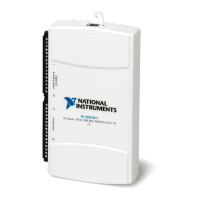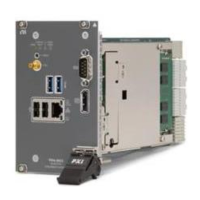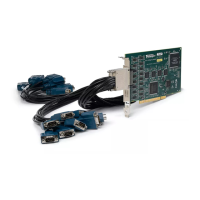© National Instruments | 5-9
NI 6612 User Manual
• DI Reference Trigger (di/ReferenceTrigger)
• DO Sample Clock (do/SampleClock)
• DO Sample Clock Timebase (do/SampleClockTimebase)
Most functions allow you to configure the polarity of RTSI inputs and whether the input is edge
or level sensitive.
RTSI Filters
You can enable a programmable debouncing filter on each PFI, RTSI, or PXI_STAR signal.
Refer to the
PFI Filters section of Chapter 4, PFI, for more information.
PXI Trigger Signals (NI PXIe-6612 Only)
PXI triggers can synchronize the operation of multiple PXI peripheral modules using routing on
the PXI chassis backplane. NI PXIe-6612 trigger signals include:
• PXI_Trigger<0..7>
• PXI_STAR
• PXI_DSTAR <A..C>
You can route many different internal signals between PXI trigger signals and the DI, DO,
Counter, and Clocking systems. Use DAQmx properties to configure the desired routes. To see
a complete list of available routes, use the device routes table for your device in MAX. Refer to
the
Routing Options section for more information.
Each PXI trigger signal has a programmable debounce filter that can eliminate noise on input
signals. Refer to the
PFI Filters section in Chapter 4, PFI, for more information.
PXI_Trigger<0..7>
A PXI chassis provides eight bused trigger lines, PXI_Trigger<0..7>, to each module in a
system. In a PXI chassis with more than eight slots, PXI trigger lines may be divided into
multiple independent buses.
PXI_Trigger<0..7> are bidirectional signals.
PXI_STAR
The NI 6612 device receives the PXI_STAR signal from a Star Trigger controller in a different
slot of the PXI Chassis. Refer to the PXI Express Specification at
www.pxisa.org for more
information.
PXI_STAR is an input signal.

